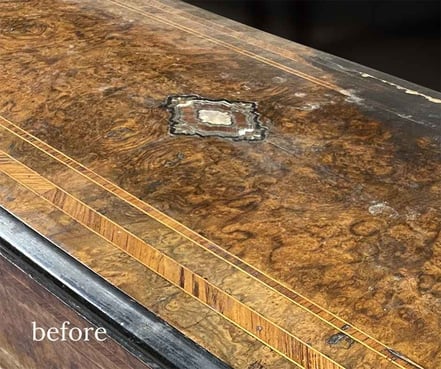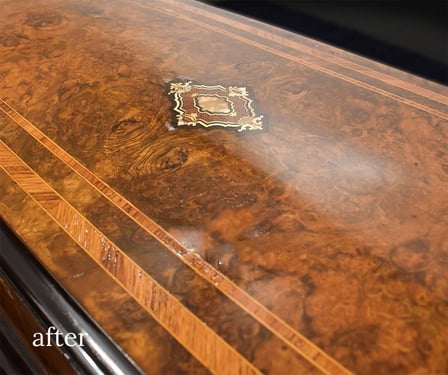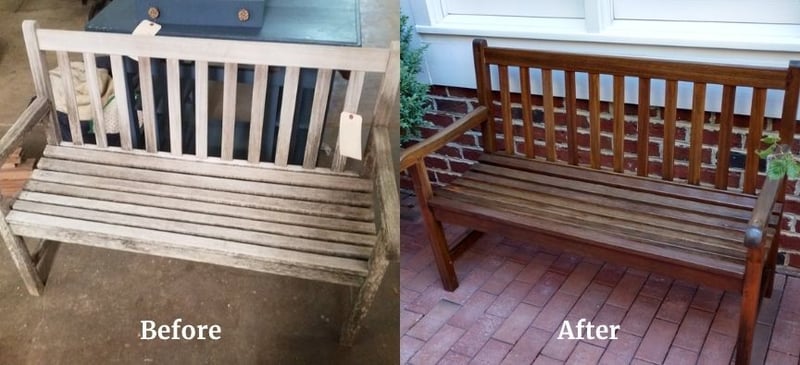Historic Antique Furniture Finishes: Shellac, Varnish & Wax Explained
Historic Antique Furniture Finishes: Shellac, Varnish & Wax Explained
By Stephanie Clough
Understanding Antique Furniture Finishes
You bought an amazing antique table from the mid 1800s, but the finish is worn.
Can it be restored to its former glory?
Absolutely!
If you find an experienced antique restorer like Mumford Restoration, a tired antique can become a crown jewel again.
In this guide, we’ll explore the most common finishes used on antique furniture: shellac, varnish, and wax.
Learn about their history and get some helpful tips for preserving pieces that feature these beautiful finishes
Photo Below: An antique desk before and after French polishing.

The Triangle’s Antique Restoration Experts
Since 1982, Mumford Restoration has been the authority on sensitive, historically appropriate furniture restoration.
You can trust us when it comes to the date, style, wood type, and finish of your antique and vintage furniture.
We’re huge furniture nerds, so we want to share our expertise in the most common furniture finishes for antique furniture.
If you’re looking for a more modern finish option, be sure to check out our guide on lacquer finishes for twentieth century vintage furniture.
Photo Below: Outdoor furniture (such as this beautiful wooden bench) generally benefits from spar varnish.

Common Finishes for Antique Wooden Furniture
Before the 1920s, the most common furniture finishes were:
- Shellac
- Varnish
- Wax
These finishes still exist today and can be the right choice for certain pieces of furniture. It all depends on your goals!
If you haven’t read our lacquer article, be sure to read it after this!
It will give you an idea of how finishes changed in the 20th century.
As in our modern furniture finish article, we will address some of the most common questions we encounter, such as:
- What is each finish made of?
- When were they most common?
- How can I protect these finishes?
Shellac
What is shellac?

Essentially, shellac is a mixture of shellac flakes and alcohol.
Shellac is a natural furniture finishing method that comes from the processed secretions of the lac beetle, which lives in Asia.
The beetle feeds on tree sap and produces a resin and wax material.
Shellac producers gather this material, dissolve it in alcohol, and then filter and dry the resulting material.
This process produces shellac flakes.
You can buy premixed shellac at home improvement stores or buy the flakes and dissolve them in either denatured alcohol or grain alcohol to make your own shellac.
You have the choice of dewaxed shellac or shellac that contains its natural waxes.
If shellac will be the only finish used on a piece, many artisans choose shellac that maintains its waxes, as it provides some additional protection to the piece.
When was shellac popular?
Shellac has been used for thousands of years.
Furniture makers began transitioning to nitrocellulose based lacquers in the 1920s, but shellac is still necessary for french polishing as well as coating paper rush in woven seats.
As it does not contain synthetic chemicals, it is safer than nitrocellulose lacquers.
Photos above and right: This antique Swiss music box came to life after it was French polished. French polishing is a traditional finishing method that relies on a shellac and resin mixture to create a beautiful, glossy finish.
What does a shellac finish look like?

A shellac finish tends to be very glossy, which may be undesirable for clients who prefer satin or matte finishes.
When shellac is combined with specific resins, it produces french polish mixture.
French polishers apply this shellac-resin mixture to certain pieces of antique furniture.
The resulting finish is prized for its wonderful reflectivity and depth, known as chatoyance.
Never seen or even heard of french polish?
Read our french polish article to learn more about this beautiful, classic finish for antique wooden furniture!
Photo Above: Shellac isn't used as a stand-alone finish as often as it used to be. However antique restorers do employ shellac-only finishes in historically appropriate furniture restorations, when the antique owner doesn't want to French polish (or if the piece always had a shellac finish).
How To Protect a Shellac Finish
Like lacquer, a shellac finish does not need help if it is in good condition.
Clean it with a damp cloth and gently dry it with a clean, soft cloth.
Keep all alcohol away from shellac, as it will soften or even entirely remove the finish.
This includes wine, beer, liquor, rubbing alcohol, and isopropyl alcohol.
Photo, right: This piano doesn't have a shellac finish, but shellac furniture benefits from gentle cleaning with a soft cloth.
Varnish

What is varnish?
Varnish is essentially resin and certain oils, which are dissolved in mineral spirits.
The components of varnish have changed over time.
Before the twentieth century, varnish makers dissolved pine tree resins into oils such as linseed oil or tung oil.
The resulting varnish was used on both interior and exterior surfaces.
Today, manufacturers most commonly use synthetic resins (phenolic, alkyd, urethane, or polyurethane) which are mixed with linseed, soybean, or safflower oil.
What is varnish used for today?
Varnish today is usually labeled “interior”(short-oil or medium oil) and “exterior” (long-oil).
Varnish with a high-oil concentration is a “long-oil varnish,” commonly known as marine varnish or spar varnish.
The additional oil lends the finish greater flexibility.
 This flexibility makes spar varnish the best finish for outdoor wood furniture that shrinks and expands as the weather changes.
This flexibility makes spar varnish the best finish for outdoor wood furniture that shrinks and expands as the weather changes.
The trade-off is that it is softer and less scratch-resistant than other finishes.
Higher-quality spar varnish will use phenolic resins (which are more UV resistant) and tung oil.
However, most home improvement stores sell spar varnishes with alkyd or polyurethane resins mixed in oil.
The polyurethane makes the varnish more affordable as well as heat- and scratch-resistant, but it is less UV-resistant than phenolic resin.
Short-oil or medium-oil varnish produces a very hard, shiny finish and can be used for indoor furniture and woodwork, but the resulting finish is very inflexible.
Antique refinishers avoid using this varnish on indoor furniture as it is prone to cracking, particularly when furniture experiences temperature or humidity fluctuations.
Photos Above: An outdoor table is beautiful and protected after it is refinished and coated in spar varnish.
How to Maintain Varnish
To extend the life of your spar varnished outdoor furniture, try to keep it in areas that do not receive much sunlight or rain.
Varnish is resistant to water and UV-light, but it is not impervious to them.
Keep any eye on it and when you notice any peeling or thinning of the finish, have it refinished.
For interior furniture and woodwork varnish ( short- or medium-oil varnish), try to keep the humidity and temperature in your home the same all year.
You should also keep it away from direct sunlight (a good practice for all furniture), as sunlight will heat the furniture and cause it to expand.
This expansion risks cracking the finish.

Wax
The Role of Wax in Antique Furniture Finishes

Waxes for wood tend to contain a combination of beeswax, carnauba wax (a hard wax derived from the carnauba palm), and mineral oil.
Thanks to the hard carnauba wax, a wax finish can be polished to an attractive shine.
When were wax finishes used?
For thousands of years, cultures across the world have used wax to protect wood.
In Western cultures, wax was a primary wood finish until the mid-nineteenth century, when shellac supplanted it.
Wax became less popular over time, but it never disappeared.
It continues to be used as a furniture finish, as many collectors and antique specialists insist on applying only wax to finish particularly valuable antique pieces.
Photo Above: Owners of very old antiques may choose to wax their pieces, instead of applying shellac or other finishes.
How can I protect and maintain my waxed furniture?

You should be as gentle as possible with furniture that has only a wax finish
Unfortunately, wax offers minimal protection.
It is a soft finish, so it can not protect furniture from scratches and is too thin to effectively resist water penetration into particularly large wood pores.
Wax additionally is a higher maintenance finish, as a well-used piece will require frequent coatings.
Unless the item of furniture is particularly historic or a valuable piece that must be waxed to maintain its character or value, a more protective long-term coating will better protect your wood furniture.
Photo, Right: Cleaning with a soft cloth is the easiest way to maintain your furniture's finish, whether it is wax, shellac, or varnish.
Choosing the Right Finish for Your Antique Furniture
It can be challenging to find the right finish for your furniture.
You have to consider the age of the piece, its collectability, its usage, and what finish it already has.
You can find books that explain the style, origin, and the most likely finishes for a variety of antique furniture.
However, these books will likely not be able to tell you if your furniture has been altered or refinished over time.
You need an expert for that.
That’s why Mumford Restoration is here!
Photo Above: An antique side table before Mumford Restoration French polished it.
How to Restore and Maintain Antique Wood Finishes
Mumford Restoration’s specialists have decades of experience and know how to evaluate your antiques and heirlooms.
You can trust us to recommend the most appropriate and beneficial furniture finish.
Whether you want to preserve, refinish, or restore your antique, we can help you.
Call 919-510-6310 to speak to one of our specialists.
Or you can submit photos using our online form and we will reach out to you soon!
Photo Above: An antique side table after Mumford Restoration French polished it.
About
About the author: Stephanie Clough
Stephanie Clough is Mumford Restoration's Marketing Coordinator and Antique Repair Specialist. She has an M.P.S. in Building Preservation and an M.A. in Russian and Eastern European Studies. Stephanie came to Mumford Restoration as an apprentice antique restorer in 2022 and trained under Bernard Mumford until she joined us as a full-time restorer. She then moved on to Marketing and now combines her writing and research background with the restoration lessons Bernard taught her!
Learn MoreRelated
What Is French Polish? Traditional Wood Finishing Explained
You found the most beautiful antique table in an antique store. You just couldn’t leave the shop...By Stephanie Clough
Love It or Leave It: Is Your Antique Furniture Worth Restoring?
It was love at first sight. From the moment you saw that chair at the estate sale, you knew it was...By Stephanie Clough

